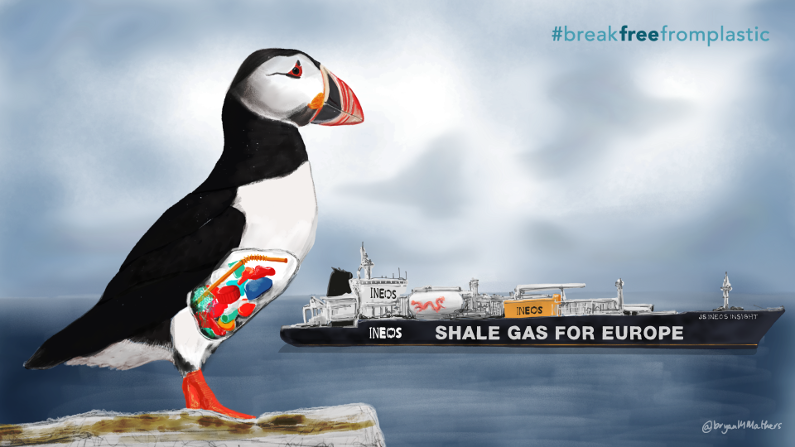 I guess that when people think of plastic pollution most of the time they think of single use plastic items (such as plastic bags, cotton buds, plastic straws, and food & beverage packaging).
I guess that when people think of plastic pollution most of the time they think of single use plastic items (such as plastic bags, cotton buds, plastic straws, and food & beverage packaging).
I also guess that – when people think about getting active against plastic pollution – some people would like to introduce bans on single-use plastic bags and cotton buds as well as bottle deposit-return and recycling schemes – basically trying to help reduce the use of polluting plastic in their daily lives.
However, the core of the problem lies in the business of virgin plastic production where the key corporations totally rely on, or even represent major oil and gas companies. Unfortunately, these guys are not keen to reduce plastic production at all because that’s what makes both theirs and their shareholders deep pockets happy.
Shale gas and fracking is creating a plastics renaissance in the U.S.
It is increasingly clear that the plastics industry in the United States has reaped massive hidden benefits from the environmentally destructive fracking boom. Hydraulic fracturing (or fracking) injects large quantities of fresh water, sand and toxic chemicals under high pressure to release oil and gas that are tightly held in rock layers.
The fracking boom has also produced an oversupply of cheap ethane in the past few years. This surge has been a boon for the plastics industry, which relies on petrochemical manufacturing to turn ethane (i.e. the so-called “wet gas” component of natural gas) into plastics. According to a recently published IEA report, the United States is home to around 40% of the global production capacity for ethane-based petrochemicals.Petrochemicals are about to rapidly becoming the largest driver of global oil (including “wet gas” or ethane) consumption – ahead of trucks, aviation and shipping. Today, the chemical sector is already the largest industrial consumer of fossil fuels, accounting for 14% of global oil (including ethane) and 8% of gas primary demand. The IEA expects that cheap ethane consumption will grow by 70% until 2030, in part due to the expansion of US exports to regions such as Europe.
According to the American Chemistry Council, a total investment of $202.4 billion for 333 petrochemical projects have been announced since 2010, with 53 percent already completed or under construction. Appalachia, a region in Pennsylvania that has been already hit hard by massive fracking development in the last 10 years could turn into the largest gas-producing region in the US (accounting for 37% by 2040).
Fracking & plastics’ profiteer you’ve never heard of is the richest man in the UK
The CEO (and basically owner) of major petrochemical giant Ineos, Jim Ratcliffe, has made a fortune by #Fracking4Plastics and it has helped him become the richest man in the UK.
He is the main driving force behind the establishment of an already existing supply chain of fracked US gas that Ineos uses to produce plastics in Europe. The Ineos Dragon Ships crossing the Atlantic emblazoned with the slogan “Shale Gas for Europe” are leaving more than a toxic legacy in Europe — they are fueling the proliferation of fracking in Pennsylvania, a state that already struggeled with the impacts of oil and gas industry pollution. As a matter of course, Ineos tries to downplay the risks of fracking and plastics production; Jim Ratcliffe compared environmental accidents to getting a car tyre puncture.
No wonder. His fortune has been built on it.
Ineos is Europe’s largest ethylene producer, with ethylene being the most important chemical building block for plastics, solvents and fibres. The company has operated chemical plants for nearly two decades, but in that short time many of its facilities have been bedeviled by environmental problems. Its dozens of manufacturing facilities across Europe have been responsible for releases of toxic chemicals, leaks, fires and explosions that have endangered workers, communities and the environment. In 2016, Ineos’ Grangemouth complex was Scotland’s top emitter of carbon dioxide. And Ineos is currently facing prosecution over gas-flaring pollution breaches at the Grangemouth facility.
In May 2018, about 450,000 plastic pellets were found on a single beach in Scotland, not very far away from Ineos’ biggest facility in the UK. Endangered Scottish puffins have also been found with plastic pellets in their stomachs. Experts believe that 15 percent of the puffins population that lives in the Firth of Forth (where the Grangemouth chemical complex of Ineos is located) could suffer from swallowed plastic pellets.
Plastic – mainly in the form of pellets or so-called nurdles – has already littered 73 percent of UK’s 279 shorelines. Several studies have shown that sea salt around the world is contaminated by plastic. Plastic fibres have been found in tap and bottled water around the world; in 2017 plankton was caught on camera eating plastic and we now have scientific evidence that degrading plastic emits methane and represents a hitherto unrecognised source of climate change.
Personally, I say “enough is enough” It’s time to stand up and make a difference. It’s time to hold upstream virgin plastic producers for the pollution they’re causing responsible.
It’s time to unite, fight #Fracking4Plastics and companies like #IneosVthePeople.
It’s time to #BanFrackingNow to #BreakFreeFromPlastic!


